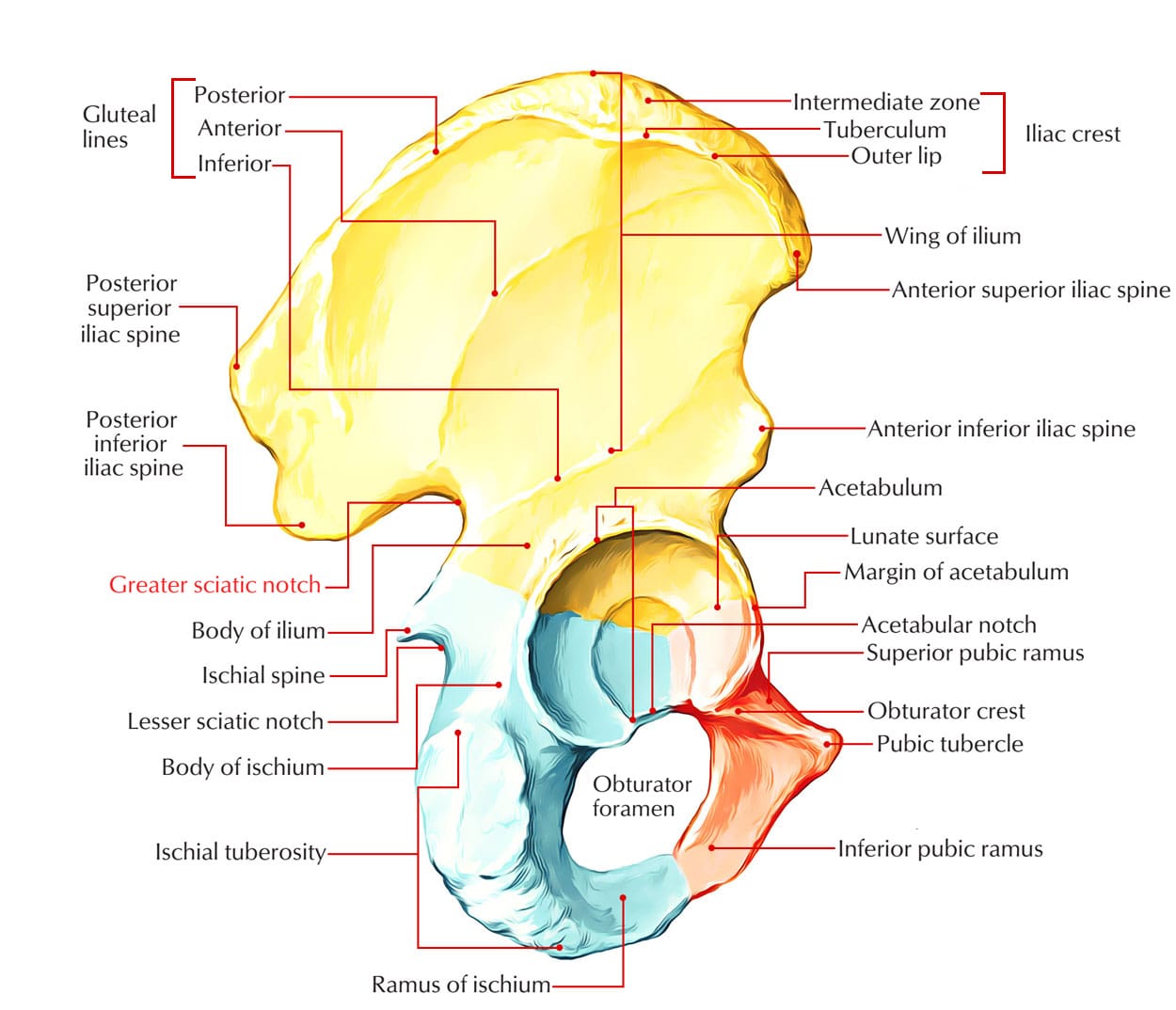This comprehensive guide explores the intricacies of the greater sciatic foramen, a crucial pelvic gateway for major nerves, blood vessels, and muscles, including the sciatic nerve—the body’s longest. We’ll delve into its anatomy, function, clinical significance, and highlight how variations in the piriformis muscle, which passes through the foramen, can impact conditions like sciatica. Understanding this anatomical structure is essential for accurate diagnosis and effective management of pelvic and lower limb conditions.
Decoding the Foramen: Location and Structure
The greater sciatic foramen is an opening located at the back of the pelvis, framed by the sacrotuberous and sacrospinous ligaments. These ligaments act like sturdy guide ropes, defining the boundaries of the foramen and converting the greater sciatic notch into a complete opening. The piriformis muscle divides the foramen into two distinct passages:
- Suprapiriform Foramen: Located above the piriformis muscle. Primarily transmits the superior gluteal artery, vein, and nerve.
- Infrapiriform Foramen: Situated below the piriformis muscle. This passageway carries several crucial structures (discussed in the next section).
Navigating the Passageways: What Goes Through?
The greater sciatic foramen functions as a critical conduit for numerous structures, each with a distinct role. Remembering these structures can seem daunting, but the mnemonic “POPS IQ” can help(Note: While useful, this mnemonic’s accuracy varies across sources and should be considered a learning aid rather than a definitive anatomical guide).
| Mnemonic | Structure Passing Through Greater Sciatic Foramen | Location Relative to Piriformis Muscle |
|---|---|---|
| P | Pudendal Nerve | Below |
| O | Obturator Internus Muscle and Nerve | Below |
| P | Posterior Cutaneous Nerve of the Thigh | Below |
| S | Sciatic Nerve | Below |
| I | Inferior Gluteal Vessels and Nerve | Below |
| Q | Quadratus Femoris Muscle (Note: The inclusion of Quadratus Femoris in this mnemonic is debated among anatomical sources.) | Below |
Structures Passing Through the Infrapiriform Foramen (Mnemonic “POPS IQ”):
- Pudendal Nerve: Essential for pelvic floor muscle function, bladder control, and sexual function.
- Obturator Internus Muscle and Nerve: This muscle and its corresponding nerve contribute to hip external rotation.
- Posterior Cutaneous Nerve of the Thigh: Provides sensation to the skin on the back of the thigh.
- Sciatic Nerve: The body’s longest and thickest nerve, providing sensation and motor control to the leg and foot.
- Inferior Gluteal Vessels (Artery and Vein) and Nerve: Supply blood and innervation to the gluteus maximus muscle, critical for hip extension and stability.
- Quadratus Femoris Muscle: A small hip muscle involved in external rotation. (Note: Some sources dispute the inclusion of Quadratus Femoris within the mnemonic.)
Structures Passing Through the Suprapiriform Foramen:
- Superior Gluteal Artery, Vein, and Nerve: Supply blood and innervation to the gluteal muscles, crucial for hip abduction and stability.
Clinical Significance: When Things Go Wrong
Compromise of structures within the greater sciatic foramen, particularly the sciatic nerve, can lead to sciatica, a debilitating condition characterized by radiating leg pain. Several conditions are associated with the greater sciatic foramen:
- Sciatica: Often caused by sciatic nerve compression or irritation within the foramen, maybe due to a herniated disc, bone spur, or piriformis syndrome. Symptoms may include pain, tingling, numbness, or weakness radiating down the leg.
- Piriformis Syndrome: The piriformis muscle can compress the sciatic nerve, leading to sciatica-like symptoms. Diagnosis can be challenging due to its similarity to other conditions. gfta
- Trauma: Pelvic fractures can damage the foramen and its contents, potentially causing nerve and vascular injuries.
- Pelvic Floor Dysfunction: Emerging research suggests a link between the greater sciatic foramen and pelvic floor stability, with implications for conditions like incontinence and pelvic pain. Learn more about the gallbladder meridian and its influence on pelvic health.
The Piriformis Puzzle: Variations and Implications
The piriformis muscle, passing through the greater sciatic foramen, plays a key role in both hip movement and potential sciatic nerve compression. Variations in its anatomy, such as its attachment points and relationship to the sciatic nerve, can influence the risk of nerve compression and subsequent sciatica. Ongoing research is exploring these variations and their clinical relevance.
Sexual Dimorphism: A Wider View
The greater sciatic foramen is generally wider in females than in males, likely an adaptation for childbirth. While the exact clinical ramifications of this difference aren’t fully understood, it’s an example of the body’s incredible adaptability.
Ongoing Research and Future Directions
Our understanding of the greater sciatic foramen is constantly evolving. Research continues to explore its intricate anatomy and its role in various conditions. Some areas of active study include:
- Advanced imaging techniques for better visualization of the foramen and surrounding structures.
- The role of genetic and environmental factors in the development of conditions related to the foramen.
- Development of more effective treatments for sciatica and piriformis syndrome, including targeted therapies and minimally invasive procedures.
Disclaimer: This information is for educational purposes and should not be considered medical advice. Consult with a healthcare professional for any health concerns or before making any decisions related to your health or treatment.
- Unlock Elemental 2 Secrets: Actionable Insights Now - April 2, 2025
- Lot’s Wife’s Name: Unveiling the Mystery of Sodom’s Fall - April 2, 2025
- Photocell Sensors: A Complete Guide for Selection and Implementation - April 2, 2025

















2 thoughts on “Understanding the Greater Sciatic Foramen: Anatomy, Function, and Clinical Significance”
Comments are closed.